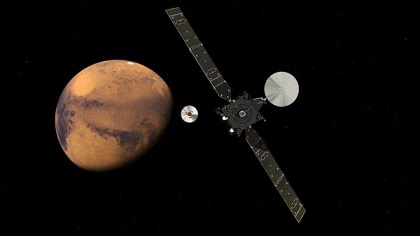Europe’s Schiaparelli spacecraft is on course to land on Mars.
The 577kg probe separated successfully from its mothership on Sunday at 14:42 GMT.
It is now on a direct path to intercept the top of the Red Planet’s atmosphere on Wednesday, according to BBC.
The module will then have just under six minutes to reduce its 21,000km/h entry speed to zero in order to make a relatively soft flop-down on to Mars’ dusty surface.
Schiaparelli is a technology demonstrator. It is intended to showcase the European Space Agency’s (Esa) ability to land on Earth’s near neighbour.
The organisation’s only previous attempt was a very short-lived effort – the UK-led Beagle-2 robot in 2003.
This craft managed to make an intact touch-down but then failed to deploy its solar panels properly, blocking any contact with home.
Schiaparelli will hope to fare better, albeit with a planned surface operation of only a few days that will be sustained by batteries.
Esa controllers in Darmstadt, Germany, were able to confirm the separation of the module from its carrier satellite – the ExoMars Trace Gas Orbiter – thanks to a radio transmission beamed across more than 170 million km of space.
Schiaparelli is now on its own; there is nothing anyone can do to change its trajectory or to give it new commands.
Its landing sequence on Wednesday is fully automated. The probe will rub off most of its entry speed thanks to a heatshield that will push up against the Martian air. The combination of a big parachute and a cluster of rockets will then bring it to a near standstill just above the surface. Schiaparelli’s final two metres will see it dump down on to its belly.
The Esa probe will emit UHF tones during its entry, descent and landing phases, which an Indian radio telescope will endeavour to capture and relay to Darmstadt. If the Indian facility can still hear Schiaparelli at 15:00 GMT (16:00 BST; 17:00 CEST) on Wednesday, it will mean the Italian-built module is safely on the surface.
While the landing attempt will no doubt occupy the media’s and the public’s attention in the coming days, Esa also has the very important task of “parking” the Trace Gas Orbiter at Mars.
Twelve hours after ejecting Schiaparelli, the satellite was due to change course to avoid following on behind the module and its collision path with the planet.
This manoeuvre will be followed by a “big burn” on the TGO’s main engine on Wednesday, to put it on a large ellipse around Mars.
The orbiter will spend the coming years studying the behaviour of atmospheric components such as methane, water vapour and nitrogen dioxide. Although present in only small amounts, these gases – methane in particular – hold clues about the planet’s current state of activity. They may even hint at the existence of life.
H.Z

